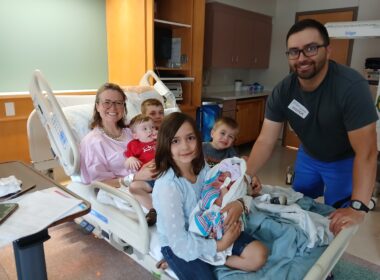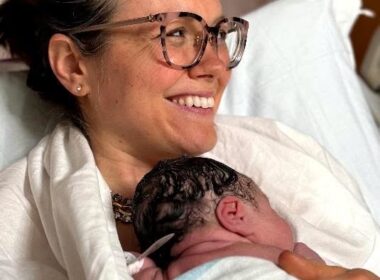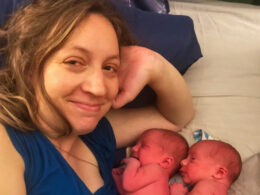When Sarah Ward was expecting her first child, she did everything in her power to have the healthiest possible pregnancy. “I did yoga, ate healthy, [and] tracked my water intake,” she told me via video chat from her home in Michigan. Even though she and her husband had recently moved, she joined a Facebook group of pregnant moms in her area and hired a local doula. Though Sarah “had a home birth on my mind,” her husband was uncomfortable with the idea, and out of respect for his wishes she sought prenatal care from a “highly-recommended” OB/GYN.
At her first prenatal appointment with her OB/GYN, he told her laboring in the tub would kill her baby
Looking back, perhaps the first clue that this OB/GYN wouldn’t be a good fit was the fact that “he was too busy to see me until 32 weeks [gestation].” Until then, Sarah’s prenatal visits were with two midwives in his practice. The first time she met the doctor himself, Sarah asked about the possibility of laboring in the bathtub at the one local hospital that had tubs in their labor and delivery rooms. She’d had several friends who’d recently had water births at home, who’d raved about the relief they’d felt from laboring in water.
Sarah was shocked and surprised when the doctor “yelled at me, and told me I was going to kill my baby with my poop!” (The doctor offered no context at all for this unusual accusation, but perhaps he was worried that her baby might aspirate water that she pooped in while pushing.*)
Though taken aback, Sarah changed the subject, and began asking other questions. She was further bewildered and confused when, rather than answering, the doctor just walked out of the room, effectively ending the appointment.
(*Editor’s note: Many hospitals with tubs only allow women to labor in water, and require women to get out when it is time to push.)
At her second appointment, her doctor “booped” Sarah on the nose
At her next prenatal appointment with the same OB/GYN, Sarah brought her doula for moral support. Once again, the doctor was dismissive of her questions, and at one point he “booped me on the nose and said, ‘oh, honey!’ like I was a two-year-old kid!” As before, after Sarah had asked several questions, the doctor simply walked out of the room.
The prenatal appointment after that was no better, as a different doctor “barged into the room” and insisted that Sarah’s baby’s amniotic fluid levels were dangerously low, based on a recent ultrasound. This new doctor, “yelling the whole time,” insisted that “this baby has to come out now, or she’s going to die!”
She was told she needed an induction right away… but she didn’t
Given the doctor’s dire warning, Sarah and her husband couldn’t believe their ears when they arrived at the hospital to start the induction and were told that—based on another ultrasound and non-stress test—there was no emergency. Sarah stayed in the hospital overnight, but was eventually sent home after more imaging confirmed that her baby was not in danger.
A neonatal specialist at the hospital urged Sarah to find another OB
Before she left, a kind neonatal specialist advised Sarah that her OB/GYN, along with his partners, had a reputation for pushing women to have medical interventions, even inductions, that they didn’t need. The specialist encouraged Sarah to find another provider, saying “If you stay with this practice, I promise you that you will end up with a C-section!”
Despite Sarah’s best efforts to find another OB/GYN practice, she was 34 weeks along, far enough that other doctors refused to take over her care. Her doula offered to connect Sarah with a midwife who would assist at a home birth, and Sarah and her husband considered this option. But just days later, during a Thanksgiving visit with family, she was “cornered” by six concerned family members “who would not let me leave the circle until I promised that I would not have a home birth.” She was even told that “having a home birth is the same thing as having an abortion.”
After this stressful conversation, Sarah and her husband were grateful to find a midwifery practice that would see her for the rest of her prenatal appointments and assist her in the hospital. Her new midwife chose to continue the non-stress tests her previous OB/GYN had ordered to ensure her amniotic fluid levels were adequate and the baby’s growth wasn’t slowing.
She was told she was “late” for her own induction
But when Sarah showed up at the hospital for her last non-stress test on December 21st, 2013, at 38 weeks gestation, the nurse who admitted her told her she was two hours late for her scheduled induction. Sarah and her husband were floored. Sarah communicated to her medical team that she had never agreed to be induced, and that she refused to be induced without a medical reason. They responded that if she went home and “something went wrong,” her insurance would likely refuse to pay her medical bills because she had “gone against medical advice.” Between a rock and an unbelievably hard place, Sarah agreed to be induced.
The induction went disastrously
Sarah had an adverse reaction to Cervidil, a medication inserted “like a tampon” to ripen the cervix, but her medical team refused to remove it. After 11 hours of misery–including vomiting, nausea, and pain–they finally took the Cervidil out. With her doula’s aid and the help of a rebozo scarf to get her baby to engage in Sarah’s pelvis, Sarah refused the Pitocin the hospital staff suggested for her next. The midwife then performed a cervical exam, where she broke Sarah’s water against her wishes, casually saying “oopsie!” afterwards.
Hours later, the midwife returned when Sarah was ready to push. In an unbelievable turn of event, Sarah’s labor occurred against the backdrop of the state’s worst ice storm of forty years, and the hospital lost power as the baby was being born.
“If this is how birth is going to be, I don’t ever want to have a baby again”
After Sarah’s daughter was born, the midwife placed her daughter on her chest but then began aggressively massaging Sarah’s abdomen. Sarah began hemorrhaging and passed out, waking up an unknown amount of time later “to complete chaos.” After all was said and done, Sarah suffered three tears and sobbed in her husband’s arms “If this is how birth is going to be, I don’t ever want to have a baby again.”
Unsurprisingly, Sarah’s traumatic labor and birth led to postpartum anxiety and depression. Tragically, when she tried to talk about her traumatic birth experiences, Sarah was met with “What does it matter? Your baby’s healthy. You’re healthy.” She summed up the next few years as a “dark” time.
But that isn’t the end of Sarah’s story.
Sarah’s second pregnancy, labor and birth were polar opposites of her first experience
Several years later, Sarah told her husband one day, “You’re going to think I’m crazy, but I think I’m ready to try again.” They conceived not long after, and thus began a completely different pregnancy, labor, and birth story.
This time, Sarah was seen by a new, respectful, and supportive midwife, who assured her that “none of that should have happened” during her first pregnancy. This validated Sarah’s experience, and helped her begin to heal from her traumatic first birth. Even though this new midwife moved when Sarah was only 17 weeks along, the midwife she saw next was equally empathetic, supportive, and outraged at the care Sarah had received during her first pregnancy.
“I’m going to do everything in my power to get you the birth that you hoped for”
She promised Sarah, “I’m going to do everything in my power to get you the birth that you hoped for.” The new midwife “was always very hands-off,” and “she always asked permission” before touching Sarah. Sarah recalled, “I don’t think she ever checked me until we were at the hospital” for labor.
“She let me labor at home, she was on the phone with me and she was like ‘You can stay there as long as you’re comfortable. You’re very in tune with your body, you’re only 15 or 20 minutes from the hospital.’ She just let me do my thing at home and she was like ‘I’m comfortable with you even staying [at home] until your contractions are 3 to 5 minutes apart.”
Her second labor in the hospital was “calm and peaceful”
When the time came for Sarah to go to the hospital, “everything was very calm and peaceful.” While walking the halls, Sarah said “It feels like there’s a softball between my legs right now!” Sarah returned to her room and the midwife told her “Well, you’re doing great. Your son is coming out in his [amniotic] sac. So you can keep doing what you want to do and we’ll just take our time. Or, if you would like me to break your water, I am more than happy to do that because he is already coming out. He will be here in less than 20 minutes.”
Sarah told the midwife to go ahead and break her water. “She breaks my water, and she was on a roll-y chair and she just slid back and gave me space. I immediately remember flipping over on my hands and knees. I had also done yoga very regularly when I was pregnant with him and the most comfortable position was child’s pose. I could have sat in that position forever. And I immediately went to that position.”
Sarah gave birth minutes later on her hands and knees. “It was easy and there was, you know, pain, but I don’t remember there being pain. She handed him to me between my legs and he was laying on the bed in front of me and it was wonderful. I was so alert and he was alert.”
Her midwife’s relaxed, gentle approach helped Sarah heal from birth trauma
“I found out hours later that the cord was actually wrapped around his neck. But she was so calm when he was born, she just unwrapped it. I had no idea. And so that was so healing to experience that, it was so empowering. I just felt so good. That was just beautiful.”
Sarah had a third child several years later, and her experience mimicked her second labor and birth. She called her labor and birth “calm and how it should be, how I needed it to be. After the birth, the midwife and the students who came in said it was the easiest birth.” When she held that baby in her arms, “I had this overwhelming feeling that everyone was here. My family was complete.”
Sarah’s birth trauma was the catalyst for her work equipping other pregnant women to advocate for themselves
Sarah now works for the Guiding Star Project, “a national movement to create a wholistic, empowering healthcare alternative to mainstream women’s health care.”
Reflecting back on everything she experienced and how far she’s coming in healing from birth trauma, Sarah said of her first pregnancy and labor, “I started working with Guiding Star in 2017. I don’t know if I would have been so convicted and passionate about the work with them if I hadn’t experienced the birth trauma that I did. So it was like a blessing in disguise even though it was awful. But it’s led me down this path. I really try to advocate for women, help them know that ‘you do have choices’ and ‘trust your body because your body knows what it needs and you know what you need if you just listen.'”
Sarah’s story is an important reminder that finding a provider—whether an OB/GYN, midwife, or otherwise—who respects you and will work with you (and your body!), is one of the single most important things you can do during your pregnancy.
Additional Reading:
Traumatic birth experiences are more common than you might think
This powerful tool can help you process difficult fertility or birth experiences












Frankly, I would report a doctor and midwife like the first one to the Board of Healing Arts, professional registration, hospital board, or whomever oversees their practice. There is no good reason to put up with demeaning or unprofessional conduct.
This is why listening to and trusting women to know their own bodies is important. We need better perinatal support in the US.
Oh my goodness, yes to all of this! So many of the same things happened to me, down to the HIDEOUS things people said to me after I tried to reach out for help.